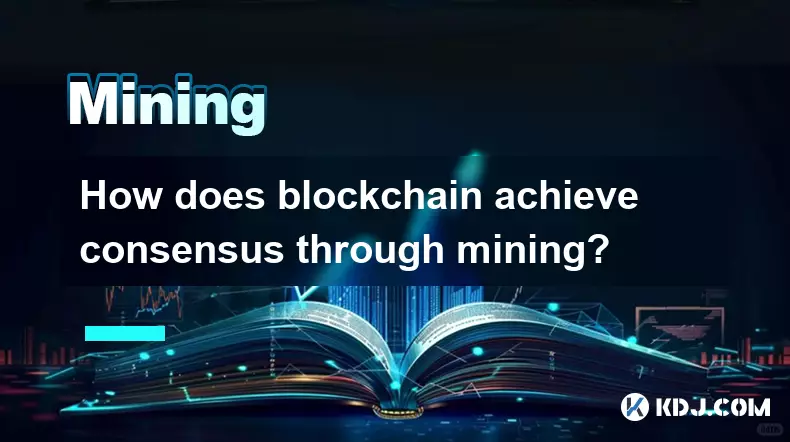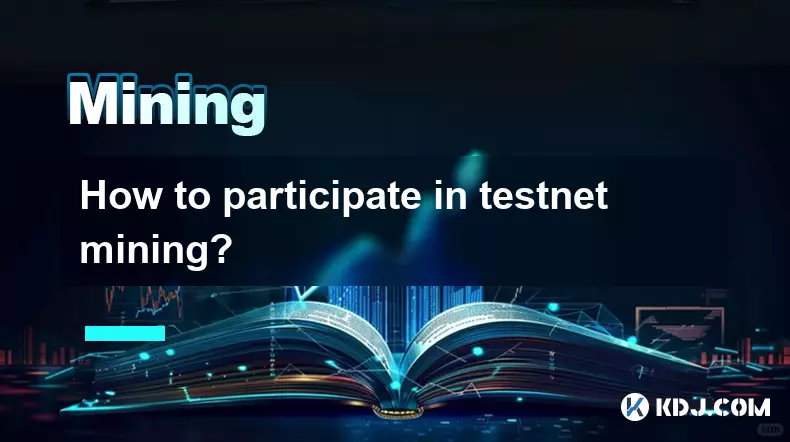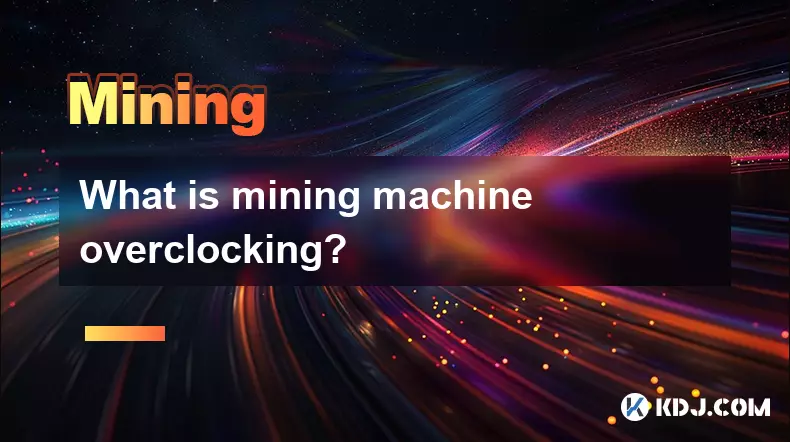-
 bitcoin
bitcoin $109523.663807 USD
-0.13% -
 ethereum
ethereum $4019.526508 USD
2.06% -
 tether
tether $1.000482 USD
0.00% -
 xrp
xrp $2.776815 USD
0.18% -
 bnb
bnb $958.942396 USD
0.12% -
 solana
solana $204.294698 USD
3.84% -
 usd-coin
usd-coin $0.999693 USD
0.00% -
 dogecoin
dogecoin $0.232115 USD
2.09% -
 tron
tron $0.338028 USD
0.84% -
 cardano
cardano $0.790920 USD
1.50% -
 hyperliquid
hyperliquid $44.871443 USD
5.60% -
 ethena-usde
ethena-usde $1.000322 USD
0.04% -
 chainlink
chainlink $21.034165 USD
2.60% -
 avalanche
avalanche $28.794831 USD
-0.54% -
 stellar
stellar $0.360466 USD
1.24%
How does blockchain achieve consensus through mining?
Blockchain mining secures networks via Proof-of-Work, where miners solve puzzles to validate blocks, ensuring decentralization and trust without central oversight.
Sep 19, 2025 at 10:55 pm

Understanding Blockchain Consensus Mechanisms
1. Blockchain technology relies on consensus mechanisms to validate transactions and maintain the integrity of the distributed ledger. These mechanisms ensure that all participants in the network agree on the state of the data without requiring a central authority.
2. Mining is a core component of the Proof-of-Work (PoW) consensus model, which was first implemented by Bitcoin. In this model, miners compete to solve complex cryptographic puzzles using computational power.
3. The first miner to solve the puzzle broadcasts the solution to the network. Other nodes verify the correctness of the solution before accepting the new block into the blockchain.
4. Once verified, the block is added to the chain, and the miner receives a reward in the form of newly minted cryptocurrency and transaction fees.
5. This process ensures that tampering with any previous block would require re-mining all subsequent blocks, which is computationally infeasible due to the cumulative effort involved.
The Role of Miners in Network Security
1. Miners act as auditors of the blockchain, dedicating hardware resources to secure the network. Their participation makes it extremely costly for malicious actors to gain control over the majority of the network’s computing power.
2. The decentralized nature of mining prevents single points of failure. No individual or group can unilaterally alter transaction history or double-spend coins without controlling more than 50% of the total hash rate.
This economic disincentive forms a foundational layer of trust in public blockchains like Bitcoin and Litecoin.3. As more miners join the network, the overall security increases because the combined computational power raises the barrier for potential attackers.
4. Mining also introduces new coins into circulation in a predictable and transparent manner, aligning incentives between miners and the long-term health of the network.
Challenges and Evolution in Mining-Based Consensus
1. One major criticism of PoW mining is its high energy consumption. Large-scale mining operations consume electricity comparable to small countries, raising environmental concerns.
2. Specialized hardware such as ASICs has led to centralization risks, where mining becomes dominated by a few well-funded entities rather than being evenly distributed among individuals.
3. Some blockchain networks have responded by adopting alternative consensus models like Proof-of-Stake (PoS), which eliminates traditional mining in favor of validators who lock up coins as collateral.
Despite these shifts, mining remains a proven method for achieving decentralized consensus in permissionless environments.4. Innovations such as merged mining allow multiple blockchains to be secured simultaneously using the same computational effort, improving efficiency without compromising security.
Impact of Mining Difficulty Adjustments
1. Blockchains like Bitcoin automatically adjust the difficulty of mining puzzles based on the total network hash rate. This keeps block generation time consistent, usually around ten minutes.
2. When more miners enter the network, the increased competition triggers a rise in difficulty, ensuring that blocks are not produced too quickly.
3. Conversely, if miners leave the network, the difficulty decreases to maintain steady block creation and prevent delays in transaction confirmation.
These dynamic adjustments preserve the predictability and reliability of the blockchain’s timeline.4. Difficulty retargeting occurs at regular intervals—every 2016 blocks in Bitcoin—and is calculated using timestamps from previous blocks, making it resistant to manipulation.
Frequently Asked Questions
What happens when two miners find a valid block at the same time?When simultaneous blocks occur, the network temporarily splits into competing chains. Nodes continue building on whichever version they receive first. The chain that accumulates more subsequent blocks becomes the accepted one, and the other is discarded—a process known as resolving a fork.
Can anyone become a miner in a Proof-of-Work system?Yes, technically any individual with sufficient computing hardware can participate in mining. However, profitability depends on factors like electricity cost, equipment efficiency, and network difficulty, which often favor large-scale operations.
Why do some blockchains move away from mining?Blockchains abandon mining primarily to reduce energy usage and avoid centralization caused by expensive mining equipment. Alternatives like Proof-of-Stake aim to achieve consensus more sustainably while maintaining security through different economic incentives.
Disclaimer:info@kdj.com
The information provided is not trading advice. kdj.com does not assume any responsibility for any investments made based on the information provided in this article. Cryptocurrencies are highly volatile and it is highly recommended that you invest with caution after thorough research!
If you believe that the content used on this website infringes your copyright, please contact us immediately (info@kdj.com) and we will delete it promptly.
- BlockchainFX: The Crypto Presale Primed for a 2025 ROI Explosion
- 2025-09-27 18:25:19
- ETH Price Check: Smart Money Stays Cool Amidst ATH Rollercoaster
- 2025-09-27 18:25:19
- Aster Price, MrBeast, and DEX Volumes: What's the Buzz?
- 2025-09-27 18:45:11
- Shiba Inu, Meme Coins, and MAGACOIN FINANCE: What's Next?
- 2025-09-27 18:45:11
- Aster DEX: Navigating DeFi's Future with Price Predictions and Key Insights
- 2025-09-27 18:50:01
- Virtuals Protocol's New Genesis: A Deep Dive into the Launch and $VIRTUAL's Potential
- 2025-09-27 18:50:01
Related knowledge

The difference between staking and mining
Sep 24,2025 at 05:18am
Understanding Staking in the Cryptocurrency Ecosystem1. Staking involves holding funds in a cryptocurrency wallet to support the operations of a block...

How to participate in testnet mining?
Sep 22,2025 at 09:18am
Understanding Testnet Mining in the Crypto Ecosystem1. Testnet mining is a method used by blockchain developers to simulate real-world conditions on a...

How to dispose of abandoned mining machines?
Sep 19,2025 at 08:19pm
Assessing the Condition of Abandoned Mining Rigs1. Begin by inspecting each mining machine for visible damage, corrosion, or missing components. Machi...

How to identify high-quality mining pools?
Sep 21,2025 at 03:19pm
Reputation and Track Record1. A mining pool’s reputation is built over time through consistent performance and transparency. Pools that have operated ...

Advantages of decentralized mining pools
Sep 20,2025 at 04:36pm
Enhanced Security and Resistance to Censorship1. Decentralized mining pools operate on blockchain-based smart contracts, eliminating the need for a ce...

What is mining machine overclocking?
Sep 21,2025 at 07:19pm
Understanding Mining Machine Overclocking1. Mining machine overclocking refers to the process of increasing the operating frequency of a cryptocurrenc...

The difference between staking and mining
Sep 24,2025 at 05:18am
Understanding Staking in the Cryptocurrency Ecosystem1. Staking involves holding funds in a cryptocurrency wallet to support the operations of a block...

How to participate in testnet mining?
Sep 22,2025 at 09:18am
Understanding Testnet Mining in the Crypto Ecosystem1. Testnet mining is a method used by blockchain developers to simulate real-world conditions on a...

How to dispose of abandoned mining machines?
Sep 19,2025 at 08:19pm
Assessing the Condition of Abandoned Mining Rigs1. Begin by inspecting each mining machine for visible damage, corrosion, or missing components. Machi...

How to identify high-quality mining pools?
Sep 21,2025 at 03:19pm
Reputation and Track Record1. A mining pool’s reputation is built over time through consistent performance and transparency. Pools that have operated ...

Advantages of decentralized mining pools
Sep 20,2025 at 04:36pm
Enhanced Security and Resistance to Censorship1. Decentralized mining pools operate on blockchain-based smart contracts, eliminating the need for a ce...

What is mining machine overclocking?
Sep 21,2025 at 07:19pm
Understanding Mining Machine Overclocking1. Mining machine overclocking refers to the process of increasing the operating frequency of a cryptocurrenc...
See all articles









































































